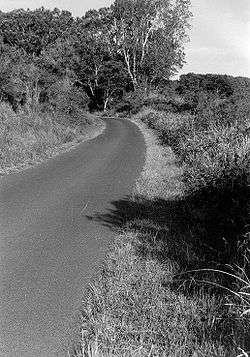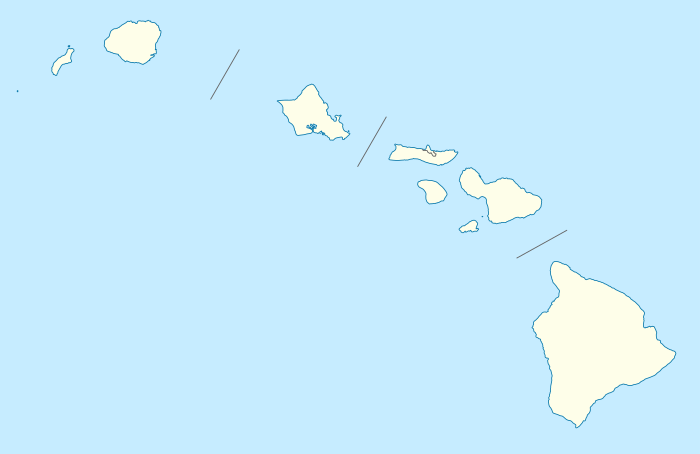ʻĀinapō Trail
The ʻĀinapō Trail was the primary route to the summit of Mauna Loa from prehistory to 1916. The trail began on the southeast flank at 2000 feet of elevation and reached Mokuaweoweo, the summit crater, at 13,200 feet (4,000 m). It was sometimes called Menzies Trail after Archibald Menzies who was the first recorded outsider to climb the mountain in 1794.[2] The Ainapo Trail was added to the National Register of Historic Places on August 30, 1974.[1]
ʻĀinapō Trail | |
 | |
 | |
| Nearest city | Mauna Loa, Hawaii |
|---|---|
| Coordinates | 19°27′39″N 155°34′39″W |
| Built | 1870 |
| NRHP reference No. | 74000290 |
| Added to NRHP | August 30, 1974[1] |
Early history
This 35-mile (55 km) route from the small community of Kapapala (near present-day Pahala) had been used in Ancient Hawaii to make offerings to Pele during eruptions. The name comes from ʻāina pō in the Hawaiian language which means "darkened land", due to heavy clouds at the mid-elevation sections.[3] At higher elevations above the clouds, the landscape is dry and barren lava rock. The climb is from about 2,000 feet (610 m) at Kapapala to above 13,200 feet (4,000 m) at the summit of Mokuaweoweo. The trail was furnished with camps which provided rest areas and an opportunity to acclimate to the increasing altitude. The camps consisted of temporary huts, or rock shelters, one of which was in a lava tube. In areas where the trail was hard to discern, rock cairns marked the way, placed to be visible along the skyline as travelers moved upwards.[2]
In 1794, Archibald Menzies, a naturalist on the Vancouver Expedition, used the trail and about 100 Hawaiian porters to reach the summit and measure its elevation with a barometer.[4] Lieutenant Charles Wilkes of the 1840 United States Exploring Expedition first attempted to use a shorter route, but resorted to the Ainapo trail after making much slower progress than he planned in his trip to the summit.[5] The trail was widened in 1870 and again in 1913 when horses and mules started bringing more visitors to the summit.
Decline and revival
In 1915 the United States Army built a new trail directly from Kilauea Crater to Mokuaweoweo which was maintained by the National Park Service when the Hawaii Volcanoes National Park was formed in 1916. The historic route fell into disuse since the lower elevations covered private land used for ranching and farming.[2] Today, only the section of about 11 miles (18 km) above 11,650 feet (3,550 m) remains in its original condition.[6] The 200 feet (61 m) on either side of the trail in this area was added to the National Register of Historic Places on August 30, 1974, as site 74000290[2] and is state historic site 10-52-5501.[7]
In the late 1990s a modern shelter was built at a historic camp site at an elevation of 7,750 feet (2,360 m).[8] The lower area of Kapapala is now a private ranch, although hunting and camping can be arranged.[9] Modern trails can now be taken from a trailhead on Ainapo road north of Hawaii Belt Road at coordinates 19°20′18″N 155°23′43″W, through the Kapapala State Forest Reserve, to the historic section of the Ainapo trail, all the way to the summit.[10]
References
- "National Register Information System". National Register of Historic Places. National Park Service. April 15, 2008.
- Russell A. Apple (July 18, 1973). "National Register of Historic Places Inventory-Nomination: Ainapo Trail" (pdf). National Park Service. Retrieved July 3, 2009. Cite journal requires
|journal=(help) - "lookup of ainapo". Hawaiian place names web site. Retrieved July 3, 2009.
- Archibald Menzies (1920). William Frederick Wilson (ed.). Hawaii Nei 128 Years Ago: Journal of Archibald Menzies, kept during his three visits to the Sandwich or Hawaiian Islands in the years 1792–1794. New freedom. p. 197. Retrieved July 3, 2009.
- Charles Wilkes (1849). Narrative of the United States Exploring Expedition. Volume IV. pp. 111–162. ISBN 0-665-53849-9.
- "Ainapo Trail". List of Classified Structures. National Park Service. November 29, 2008. Archived from the original on May 21, 2011. Retrieved November 30, 2008.
- Historic Places in Hawaii County on official state web site
- "Environmental Assessment for Ainapo Trail Shelter" (PDF). Hawaii Division of Forestry and Wildlife. September 24, 1997. Archived from the original (PDF) on July 27, 2009.
- "Kapapala Ranch". Pahala Village, Hawaii. Archived from the original on October 7, 2011. Retrieved July 3, 2009.
- "Ainapo Trail". Na Ala Hele, Hawaii state Department of Land and Natural Resources.
| Wikimedia Commons has media related to Ainapo Trail. |